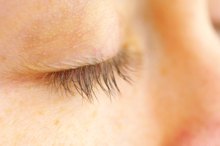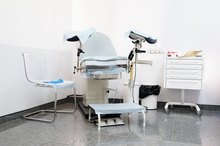Bartholin's Cyst vs. Ingrown Hair
Two common causes of uncomfortable bumps or lumps in the female genital area are Bartholin's cysts and ingrown hairs. Although you should not rely on self-diagnosis alone when dealing with your gynecologic health, understanding these two common problems may make you less anxious as you wait for your diagnosis and condition to resolve.
Facts
The Bartholin's glands are located on either side of the vaginal opening. When the opening to a Bartholin's gland becomes clogged, fluid builds up inside the gland, causing a cyst. If the cyst becomes infected, it is called an abscess.
Ingrown hairs result when a hair does not emerge properly from its follicle and grows into the surrounding skin. The term ingrown hair is often applied to hairs that do emerge from their follicle but then curve down to grow into the surrounding skin. Neither Bartholin's cysts or ingrown hairs are sexually transmitted diseases.
- The Bartholin's glands are located on either side of the vaginal opening.
- Neither Bartholin's cysts or ingrown hairs are sexually transmitted diseases.
Identification
Home Treatment for Vaginal Ingrown Hairs
Learn More
Both Bartholin's glands and ingrown hairs can form painful bumps and can become infected. The key to determining which condition you have is often where the problem is located. Bartholin's cysts only occur in women and only where the Bartholin's glands are located. Ingrown hairs only occur where hair grows, and they may occur in men or women. You may need to see a physician to get an accurate diagnosis, and you should consult a physician if you suspect any type of infection.
- Both Bartholin's glands and ingrown hairs can form painful bumps and can become infected.
- Bartholin's cysts only occur in women and only where the Bartholin's glands are located.
Treatment
Warm, moist compresses may help relieve both Bartholin's cysts and ingrown hairs. The usual treatment for Bartholin's cysts is to create an opening so that the built-up fluid can drain; sometimes a small catheter is placed in the gland to facilitate drainage. In some cases, the gland may need to be surgically removed.
Ingrown hairs usually resolve with gentle exfoliation and normal hair growth, although at times, tweezers may be used to remove the hair. Your doctor may prescribe antibiotics if either a cyst or ingrown hair become infected.
- Warm, moist compresses may help relieve both Bartholin's cysts and ingrown hairs.
- The usual treatment for Bartholin's cysts is to create an opening so that the built-up fluid can drain; sometimes a small catheter is placed in the gland to facilitate drainage.
Prevention
How to Get Rid of Ingrown Hair on the Bottom of a Scrotum
Learn More
The key to preventing both conditions is to practice proper hygiene, using a gentle cleanser in the genital area. Women should always wipe from front to back when using the bathroom to keep bacteria away from the vaginal area. Avoid feminine deodorant sprays and other similar products. Avoid tight-fitting underwear. Waxing the genital area may produce fewer ingrown hairs than shaving, and an electric razor may produce fewer ingrown hairs than shaving with a manual razor. When shaving the genital area, use a single-blade razor and shave in the direction of hair growth 1.
- The key to preventing both conditions is to practice proper hygiene, using a gentle cleanser in the genital area.
Sexual Activity
Ingrown hairs are typically no impediment to sexual activity unless they are infected, in which case you should avoid sexual activity until the infection is resolved. Bartholin's cysts can be tender and painful, in which case you should avoid sexual activity until they have healed. If you have any questions about when it is safe to resume sexual activity, ask your doctor.
Related Articles
References
- University of California Santa Barbara SexInfo: Can I Shave My Pubic Hair?
- MedlinePlus. Acne.
- Cleveland Clinic. Ingrown hair. Updated February 28, 2018.
- Merck Manuals. Ingrown beard hairs. Updated October 2019.
- Cleveland Clinic. Ingrown hair: Management and treatment. Updated February 28, 2018.
- Ogunbiyi A. Pseudofolliculitis barbae; current treatment options. Clin Cosmet Investig Dermatol. 2019;12:241-247. doi:10.2147/CCID.S149250
- MedlinePlus. Folliculitis. Updated October 8, 2018.
- Zaenglein AL, Pathy AL, Schlosser BJ, Alikhan A, Baldwin HE, et. al. Guidelines of care for the management of acne vulgaris. Journal of the American Academy of Dermatology. 2016; 74(5): 945-73. doi:10.1016/j.jaad.2015.12.037
Writer Bio
Stephanie Crumley Hill is a childbirth educator who for more than 20 years has written professionally about pregnancy, family and a variety of health and medical topics. A former print magazine editor, her insurance articles for “Resource” magazine garnered numerous awards. She holds a Bachelor of Arts in English from the University of Georgia.








